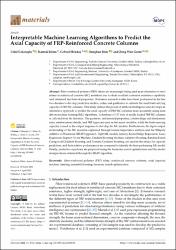Interpretable machine learning algorithms to predict the axial capacity of frp-reinforced concrete columns
Citation
Çakıroğlu, C., Islam, K., Bekdaş, G., Kim, S., & Geem, Z. W. (2022). Interpretable machine learning algorithms to predict the axial capacity of frp-reinforced concrete columns. Materials, 15(8), 2742.Abstract
Fiber-reinforced polymer (FRP) rebars are increasingly being used as an alternative to steel rebars in reinforced concrete (RC) members due to their excellent corrosion resistance capability and enhanced mechanical properties. Extensive research works have been performed in the last two decades to develop predictive models, codes, and guidelines to estimate the axial load-carrying capacity of FRP-RC columns. This study utilizes the power of artificial intelligence and develops an alternative approach to predict the axial capacity of FRP-RC columns more accurately using data-driven machine learning (ML) algorithms. A database of 117 tests of axially loaded FRP-RC columns is collected from the literature. The geometric and material properties, column shape and slenderness ratio, reinforcement details, and FRP types are used as the input variables, while the load-carrying capacity is used as the output response to develop the ML models. Furthermore, the input-output relationship of the ML model is explained through feature importance analysis and the SHapely Additive exPlanations (SHAP) approach. Eight ML models, namely, Kernel Ridge Regression, Lasso Regression, Support Vector Machine, Gradient Boosting Machine, Adaptive Boosting, Random Forest, Categorical Gradient Boosting, and Extreme Gradient Boosting, are used in this study for capacity prediction, and their relative performances are compared to identify the best-performing ML model. Finally, predictive equations are proposed using the harmony search optimization and the model interpretations obtained through the SHAP algorithm.

















